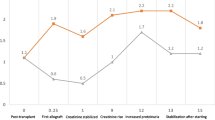Abstract
Familial non-immune-mediated glomerulopathy has recently been recognized as a distinct clinical entity. The presentation includes proteinuria, often in the nephrotic range, microscopic hematuria, and hypertension. Renal function may remain intact long term, or may progress slowly to renal failure. A 3-year-old boy was referred with proteinuria (>8 g/day), microscopic hematuria, and hypertension (184/150 mmHg). Renal function was intact. Diagnostic evaluation uncovered no evidence of systemic disease. A renal biopsy specimen showed no immune deposits in the glomeruli, but fibronectin deposits were detected in the peripheral loop and mesangium by immunofluorescence. The basement membrane was intact. Twelve other family members subsequently were found to have some renal pathology. Renal function was preserved during 7 years of follow-up. The pathogenesis of fibronectin glomerulopathy is discussed.
Similar content being viewed by others
Author information
Authors and Affiliations
Additional information
Received: 06 April 2001 / Revised: 13 December 2001 / Accepted: 13 December 2001
Rights and permissions
About this article
Cite this article
Niimi, K., Tsuru, N., Uesugi, N. et al. Fibronectin glomerulopathy with nephrotic syndrome in a 3-year-old male. Pediatr Nephrol 17, 363–366 (2002). https://doi.org/10.1007/s00467-002-0833-2
Issue Date:
DOI: https://doi.org/10.1007/s00467-002-0833-2




